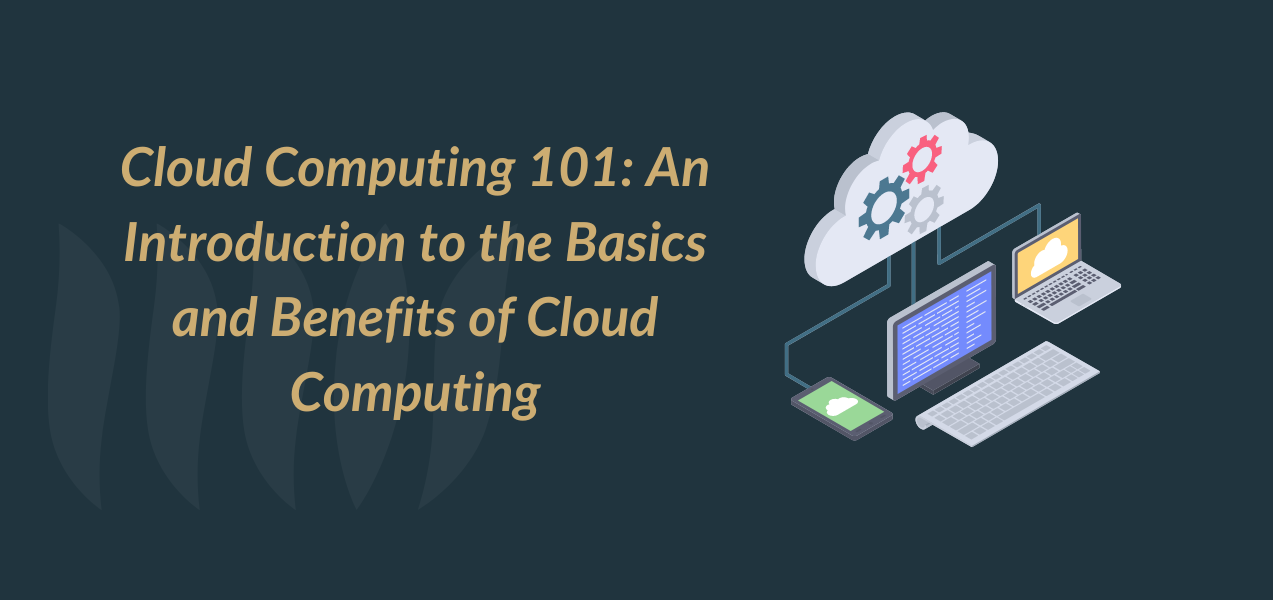Introduction to Cloud Computing
Everyone is familiar with drives, whether they are USB or hard drives. These devices are such a convenient way to store data. Even if you are moving countries, you can carry all your files and computing resources in a small object that fits in your palm. However, the highest storage capacity for a flash drive in any store is 2TB (terabytes).
The average US bank needs about 1 exabyte of data storage. You would need about 500,000 flash drives with a 2TB storage capacity to store a bank’s data.
Organizations like banks that handle such enormous data use data servers. These servers are expensive and high maintenance.
Cloud computing and emerging technologies eliminate the need for such servers, as you can pay cloud providers to use their data centers.
What is cloud computing?
Cloud computing is a technology that allows businesses to use computing resources and services on the Internet. You can pay for the amount of resources you use on the cloud.
It is easy to assume the cloud is in the sky. People first used the cloud metaphor to describe data as a wireless, floating, and drifting entity.
The cloud refers to globally connected data servers. They form a virtual ecosystem to store and retrieve data. Cloud computing is all services and technologies to utilize it.
Streaming a video online is one great feat possible because YouTube and the like are running on a cloud infrastructure. These videos are stored in the cloud; you can access them on your phone and the internet. When you send your videos to Google Drive, you also access the cloud for storage.
Apart from cloud storage, other cloud solutions are also delivered over the Internet. Gaming enthusiasts also have a similar opportunity. It sounds wild, but streaming games on the cloud is now possible. Gone are the days when you’d need a supercomputer to play your favorite game.
Types of cloud computing services

A cloud service provider provides businesses with cloud services to store, compute, and network data.
There are four broad categories into which computing services are shelved: IaaS (infrastructure as a service), PaaS (platform as a service), serverless computing, and SaaS (software as a service). They are often referred to as a stack because they form a cloud application stack.
This form of cloud computing focuses on providing the IT infrastructure a business needs. This is a cost-effective method of managing the business’s hardware cost. IaaS allows businesses to migrate their application or workloads to the cloud without worrying about refactoring their underlying architecture or investing in hardware components.
The major focus of IaaS is using cloud computing to manage virtual machines, operating systems, data, and applications. Users have the autonomy to create the underlying infrastructure their business needs. It also makes for faster innovation as teams can deploy high-performance web apps faster as they already have the infrastructure needed. Businesses that want more control over their IT infrastructure without worrying about the physical setup use IaaS. Some popular IaaS providers include AWS (Amazon Web Services) and Microsoft Azure.
Platform as a Service (PaaS)
PaaS takes the management of cloud computing infrastructure off your hands. This way, your organization can focus on building web applications without controlling the underlying infrastructure. Google App Engine and Heroku handle server management and are examples of PaaS.
PaaS streamlines the application development process. It can also incorporate serverless computing.
Software as a Service (SaaS)
Imagine building your own Google Docs or Microsoft Office suite to carry out basic tasks as a professional. SaaS eliminates the need to own a server or build a software application to fit your business needs.
These software applications are built and hosted on the cloud with specific functions and use cases in mind. Many cloud applications are hosted so users can pay small fees to access the services. There are office productivity suites like Slack, communication and collaboration tools like Microsoft Teams, project management applications like Trello, and so on.
Types of Cloud Environments

Cloud computing is the delivery of internet computer services by major cloud providers. Cloud providers create different environments to provide on-demand delivery of computing infrastructure. These services can be deployed in a public, private, or hybrid environment. The cloud user specifies what environment fits their business needs. Let’s explore these cloud environments and their benefits. These environments are the most secure.
Public Cloud
Third-party cloud providers host public cloud environments. The complex infrastructure they build to cater to the needs of the public. Public cloud services are also built to scale; they are faster and easier to use. It is often cost-effective and less burdensome.
However, when it comes to cloud security in this environment, it is shared between cloud providers and the users of the service. You, the user, must secure your data and applications while the cloud providers secure the hardware and software infrastructure.
Private Cloud
Some private organizations often host private cloud environments, and third-party cloud providers can do the same. These organizations have changing needs, suggesting that the Infrastructure suits their needs. There is a lot more cost going into establishing an on-premise backup. This type of cloud is best for organizations with the IT infrastructure in place.
Hybrid Cloud
The users in hybrid cloud environments combine public and private cloud elements. They store and manage your data across different environments. Increasing cloud adoption made it necessary for companies to use the cloud for more sophisticated developments. The company integrates its existing cloud infrastructure with a public cloud provider.
This environment allows for transferring and sharing data and applications between a public and private cloud. Virtual private networks (VPNs), direct interconnects, or dedicated network links establish the connection.
Benefits of Cloud Computing
The history of cloud computing began in the 1960s. Modern-day cloud computing has evolved to do more than time sharing. Many companies take advantage of cloud computing to manage their data better,
Let’s address the challenges of cloud computing as well as the advantages of cloud computing.
Advantages
- Reduced cost: Most cloud services employ a subscription basis that allows users to pay for only the services they require or use. You can eliminate the hardware and infrastructure costs by migrating to the cloud as a user.
- Data recovery and backup: The biggest upside to cloud services is the ability to retrieve files anytime. If you have ever lost a file or a device that contained important files, you know how heartbreaking it can be. However, cloud computing employs redundancy to store data. Your cloud providers can help you restore lost data as long as you remember to do a cloud backup.
- Automation and ease of maintenance: Cloud applications and infrastructure are easier to maintain. Public cloud providers are responsible for handling software updates and security patches.
- Collaboration across regions: You can access cloud-based collaboration tools over the internet to facilitate teamwork, share data, and communicate in real-time. An example is Zoom.
- Security: There is a risk to your data when it is stored on the premises rather than in the cloud. Data in the cloud can be encrypted and monitored, and access to it can be managed better.
Disadvantages
- Security breaches: Hackers often aren’t the cool guys in hoodies that movies make them out to be. Data breaches and unauthorized access are often commonplace in different cloud-based enterprises. Such security risks can be very detrimental to your organization’s data. Security compliance and data privacy when you shift to the cloud are also issues.
- Downtime: It is not unusual for an application on the cloud to crash or experience a downtime. Such downtimes may affect your business operations and cost you.
- High cost: If you are a large organization with large amounts of data, you will incur a high bandwidth cost to transfer and manage data. This certainly will translate into a costly financial venture for you. If it is more economical to use an on-premise option, then you should.
- Less control of the IT infrastructure: If your organization has specific needs, cloud computing may not be a great fit. It would be best to build your infrastructure. Most large organizations do this. Although the upfront cost can be great at first, with time, it allows you the flexibility you need. As organizations grow, they often switch to building their data centers.
Using Cloud Computing
Applications of cloud computing

Cloud computing today is essential in any and every field. As long as you use a smart device, you already utilize a cloud service. On a personal level, cloud computing is how you can access many social media apps and send and receive media. Every time you update a status, you have added data to the cloud. These days, you do not have to worry about your system crashing or your phone going missing; you can always retrieve previous files from the cloud.
On an organizational level, businesses can build scalable applications, handle large amounts of data, and mitigate security risks.
Common use cases
Here are the ten most common use cases for cloud computing
- Storage of Big data
- Data archiving and recovery
- A platform for communication and collaboration
- Social networking
- Creation of virtual machines and workstations
- Electronic Records for Hospitals
- Video and Music streaming services
- Online E-commerce and Retail stores
- Business process automation
- Project management
Types of Cloud Computing
Cloud service categories
There are four major categories of cloud services:
- IaaS
- SaaS
- PaaS
- Serverless computing
These service categories can be deployed in private, public, and hybrid cloud environments.
Popular cloud service providers

There are many cloud service providers. Here are five major players and what they do.
- Microsoft: 95% of Fortune 500 companies use Microsoft Azure, a cloud service subsidiary of Microsoft, for its trusted cloud services. Microsoft Azure offers PaaS. The cloud services provided by Microsoft include GitHub (SaaS), Dynamic 365 (SaaS) and Microsoft 365 (SaaS)
- Amazon: Amazon Web service is a mixture of PaaS and IaaS. AWS offers about 175 featured services from data centers in around 190 countries globally.
- Google: Google offers a cloud platform called GCP (Google Cloud Platform), a PaaS. It also offers SaaS via the Google Workspace (G Suite).
- IBM: IBM has the IBM cloud platform combining PaaS and IaaS to give users an integrated experience. You can use IBM as your business’s open and secure public cloud.
- Alibaba: Alibaba is a Chinese company that provides services on the cloud for various e-commerce businesses.
The Future of Cloud Computing
Emerging technologies
If you understand cloud computing, you will see the enormous possibilities of this technology. According to market.us, cloud computing will surpass $2 trillion by 2032 as it continues to grow.
As this growth continues, some of the emerging technologies to look out for include:
Container technology that virtualizes operating systems and allows them to run anywhere.
There is also edge computing, an optimization technique that will allow data to be processed close to its source and enhance real-time functionality on cloud server infrastructure.
The demand for cloud computing makes a career as a cloud engineer potentially rewarding.
Implications for businesses
Businesses can now cut operation costs using cloud computing and reduce capital expenditure. There is also a lot of flexibility in using cloud services. IT can be met in real time using cloud applications and tools. Organizations that service a global audience can now do so with ease.
This means we will see more businesses build and scale with lower costs. Even startups can bootstrap easily using cloud services. A proliferation of businesses like this is a net positive for the economy.


